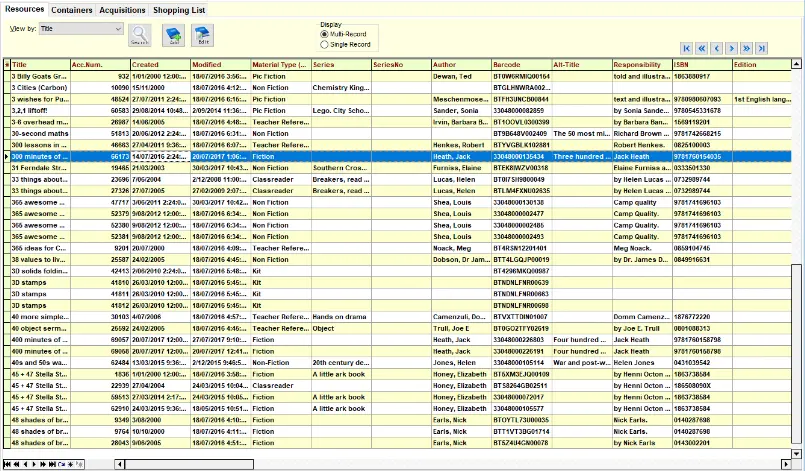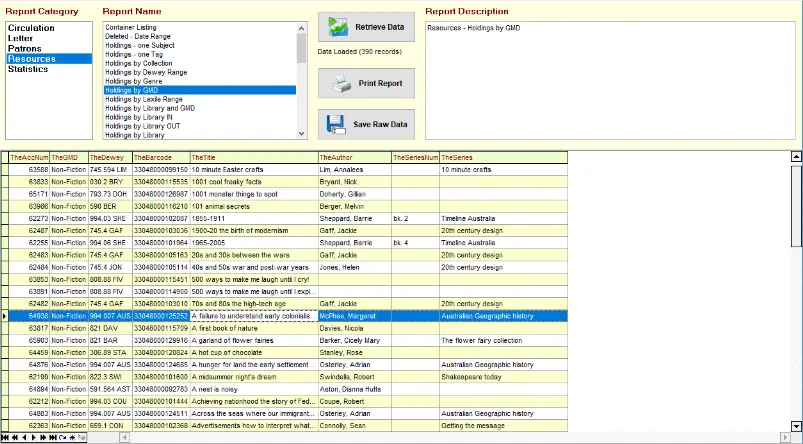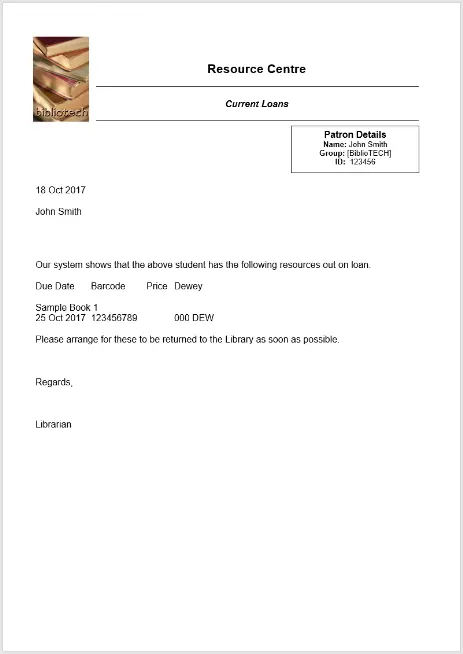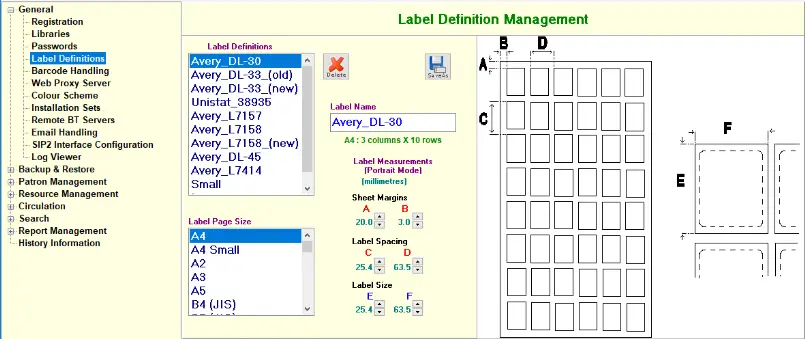Features
Overview
Why was BiblioTECH Developed?
The BiblioTECH Library Management System was developed in response to school Librarians’ requests for:
- An affordable Library Management System.
- An easy to use a Windows-based Search module.
- A substantial reduction in administration time, allowing more direct contact with the library environment itself.
Design Goals of BiblioTECH
In order to achieve these aims, the following concepts and development tools have been utilised:
- Simple English descriptions are used in preference to the use of technical jargon.
- Wherever possible, when multiple items are displayed, a 'grid' view is used.
- Common, consistent approach to display operations, thereby substantially reducing training effort.
BookHeart
- High speed development tools and database engine technology.
- High speed backup and compression technology.
- Super high speed search engine technology which can simultaneously search all the fields of a 50,000 book library for any character sequence in a fraction of a second.
- Co-existence with other applications.
- Export of resource data to allow advanced analysis and graphing.
- Use of 'pure' TCP/IP communications, thereby remaining independent of propriety technologies.
- Integrated/built-in Help system (i.e. the manual).
- Ability to utilise a variety of barcode types within a single system.
- Be updated regularly so that BiblioTECH remains current – both in terms of developments in the technological world as well as remaining relevant and accessible to librarians of today
BiblioTECH Version 8
The BiblioTECH Library System is 'Client/Server' based. That is, there are 'Server' modules which run on one computer and these are accessed via 'Client' modules running on the same or another computer across the network. The Server modules operate as standard Microsoft Windows services.
There are two sets of BiblioTECH Server modules:
'Core' Services
The Core services form the actual BiblioTECH Server. They implement the fundamental functionality of the system.
'Add-On' Services
The Add-On services provide additional functionality to the Server. These need to be installed on the BiblioTECH Server, not a Client.
During Client start-up, the Server advises the Client which Add-On services are available, allowing the Client to adjust its behaviour accordingly.
In addition to BiblioTECH Client applications, there are other ways that a user or another system can access the information held within the BiblioTECH system:
Web Interface
The BiblioTECH WWW Engine provides a web browser interface for BiblioTECH. This enables all computers, tablets & mobile phones with web browser capabilities (HTML5/CSS3 compatible) to perform searching within the BiblioTECH System.
Access by External Applications
The BiblioTECH Server responds to requests through an API, therefore facilitating direct access by non-BiblioTECH applications using these commands.
Before installing a Server, refer to the System Requirements to ensure the Server and Client computers have sufficient resources. Also refer to the Folder Usage information so you are aware of which folders BiblioTECH will use.
Core Server
The BiblioTECH Core Server provides the functionality required by most sites.
It consists of the following components:
- A fully-featured database Server, utilising multiple technologies.
- A World Wide Web Search engine/service.
- An SMTP Email Gateway.
Additionally, to enable supplementary functionality, the BiblioTECH Server can be extended through the use of several Server Add-Ons. These provide specific extensions to the Core Server to meet local needs.
- A ClickView external search engine.
- A DVC external search engine.
- A LinksPlus/WebLinks external search engine.
Client Modules
Search Module
The Search module is installed on all BiblioTECH Client computers and is used by Patrons to locate resources held by the Library.
Features include:
- An easy to read overview screen which is simple to use.
- Up to four definable search terms.
- Multi-Level Boolean operators.
- Search using 'Start of Word', 'Anywhere within a word', 'Whole Word' or 'Phrases'.
- Matching Search terms are highlighted in red.
- Resources on loan are highlighted in a deep yellow.
- Three different ways of viewing the results: Results - Brief, Results - MultiLine and Detailed View.
- Customisable GMD and GENRE icons are available for visual feedback on the Resource type.

The Search module has several user configurable settings, such as:
- Colours and fonts.
- The Librarian can define which fields are searchable under the 'All Fields' option.
- The Librarian can define which fields are displayed in both the Multi-Line and Detailed View.
- The Librarian can decide which BiblioTECH Client computers can launch and play ClickView media.
- An option to hide resources that are 'lost' or 'on order'.
- Catalogued URL links can be launched directly from Search (if enabled by the Librarian).
- 'See Also Subjects' (Local & SCIS) can be incorporated into Search.
Circulation Manager
- The Circulation Manager is used to manage the daily operations relating to Loans, Returns and Reservations. It also is used during a Stocktake.Features include:
- A simple user interface.
- Multiple Circulation Desks operating simultaneously.
- When a Patron is selected, full details of all current Loans and Reservations are displayed, with any Overdues highlighted and specially entered Librarian messages displayed.
- When a Patron is selected, their photo is prominently displayed. This is useful for confirmation and security checks – especially for new or temporary staff.
- Each of a Patron’s loans can have its Due Date updated, Reloaned, Returned or marked as Missing.
- Loans, Overdues and any Reservations for the currently selected Patron can be printed or emailed directly from the module.
- Multiple levels of access, allowing non-Librarians to be allowed to perform specific tasks without full access to the system.
- A simple user interface.

Several loan period options are available:
- A Force Due Date which sets the due date to a selected date.
- Term, Semester and Year period loans.
- 'Normal' loans.
Additionally, once loaned, the Due Date can be adjusted. If the person using Circulation has sufficient rights, they can override the system and allow patrons to have loans past their maximum loan period.
Resource Manager
Resource Manager is used to maintain information relating to the resources held on the system. These resources can be of any type (e.g. books, DVDs, websites, eBooks, equipment, toys, musical instruments, drama costumes, sheet music, electronic documents). Basically, as long as you can describe a resource, it can be catalogued and subsequently Searched, Circulated and/or Reported on.
The initial display mode is Multi-Record (a grid with selectable sort order). If you select the Single mode, the currently selected Resource will be displayed in its own panel.

The Resources Manager in Multi-Record View
New resources can be added:
- Manually.
- Copied from existing catalogue records (two methods).
- Imported from external files (e.g. MARC records downloaded from SCIS).
- Directly downloaded from SCIS.

The Resources Manager in Single Record View
Key Features:
- Once catalogued, almost all information in the catalogue record can be amended.
- Incorporates powerful editing facilities which can allow for records to be amended en-masse.
- Includes the concept of a 'Container', that is, one resource which contains several others (if a container is circulated, its contents are also automatically circulated along with it).
- Global Field Value editor.
- An Acquisitions system that is aimed at providing an aid to Librarians so that they can track those resources that they have ordered.
- Ability to export selected information into standard file formats.
- Ability to export Authority Lists.
Patrons Manager
Patrons Manager is used to maintain the list of those people who can borrow from the Library. The initial view is via a grid (selectable sort order).

The Patrons Manager
When you Add or Edit a Patron's record, the full details of that Patron will be displayed in a separate panel.
You can:
- Manually add or edit Patrons.
- Import or Update the Patrons list from a Microsoft Excel (.xls), Comma Separated Value (.csv), tab delimited Text (.txt) or CASES and CASES21 export files.
- Import or Update the Patron photographs which are displayed in Circulation.
- Edit loan parameters for Patrons, Levels and Groups.
- Print Group Lists with Barcodes and optional photos.
- Attach ‘Comments’ to Patrons which will be displayed when the Patron is selected.
- Manually add or edit Patrons.
- Import or Update the Patrons list from a Microsoft Excel (.xls), Comma Separated Value (.csv), tab delimited Text (.txt) or CASES and CASES21 export files.
- Import or Update the Patron photographs which are displayed in Circulation.
- Edit loan parameters for Patrons, Levels and Groups.
- Print Group Lists with Barcodes and optional photos.
- Attach ‘Comments’ to Patrons which will be displayed when the Patron is selected.
Reports Manager
While the various BiblioTECH modules provide some printing options, most reports are generated via Reports Manager. The base data retrieved for every report can be saved to a .csv file for editing or reviewing in an external program (e.g. Microsoft Excel).

The Reports Manager
Tabular Reports
When you select Print the report will be displayed in a 'Print Preview' screen. From here the report can be printed or exported to a .pdf or .rtf file.
Letter Reports
These reports generate ‘Letters’ which can then be either sent via email or built into a Microsoft Word mailmerge document. The letter format and content can be edited via BiblioTECH System Utilities.
Additional Reports
Additional Reports can be requested and these can be easily incorporated into the BiblioTECH System (in some cases a fee may be charged for specific reports).

A Sample Report - In this case an overdue letter
The various BiblioTECH client modules can also produce specific reports which can be printed and/or saved to a file.
For example:
Search – Search Results & Bibliography.
Patron Manager – Group Lists including barcodes; with or without photos.
Resource Manager – Grid Range printing, Spine Labels & URL Link Check.
Circulation – Patron Loans & Reservations.
Utilities – ‘History’ Grid Range printing.
System Utilities
System Utilities is used to manage all ‘Global’ settings and to perform system functions.

System Utilities
Backup
Each BiblioTECH backup contains all of the data and configuration settings required to re-establish a BiblioTECH system if necessary. A backup can be run while the system is operating. Backup files are created and named based on the date, with two backup files being created simultaneously – day and month. This means every site has both a daily and monthly archive created every time a backup is run. There are two backup options:
Automatic Backup – performed daily by the BiblioTECH server (time can be adjusted).
Manual Backup – performed as requested by the Librarian.
Libraries
BiblioTECH supports multiple 'Libraries'. In addition to the five 'system' libraries, a Librarian can define additional libraries to the system to reflect where they store their local resources. The five 'system' libraries are:
'Main' – which can be renamed.
'Lost' – a holder for resources marked as missing.
'Virtual' – a holder for non-physical resources (e.g. web URL links).
'Ordered' – a holder for resources which have been ordered and are awaiting delivery.
'Workroom' – a holder for resources which have been withdrawn from Circulation (e.g. damaged, being repaired).
A Librarian can also add additional libraries as required.
Barcodes
BiblioTECH supports a wide variety of barcode formats and it supports the use of multiple barcode formats in the same system (as long as there are no duplicates). BiblioTECH also incorporates a facility that can print barcodes for use with Patrons and Resources.
Client Installation
'Client Installation' sets can be created to allow easy installation on additional computers. BiblioTECH licensing is on a per site basis, therefore, you can install additional Clients as required.
